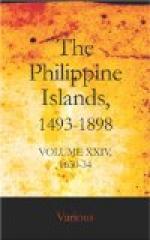[55] The native dish of rice.
[56] See Perez’s Catalogo for sketches of these friars.
[57] Spanish, Rutenos—a now obsolete name for Ruso ("Russians"). The term Ruthenians is applied to the people of Little Russia (also known as Ukrania and Ruthenia), dwelling in the steppes of Southern Russia, mainly in the valley of the Dnieper River; they have also extended into Hungary and Galicia. The reference in the text to “Russians” probably indicates only somewhat vague or erroneous notions as to the geography and political condition of Western Asia at that time: for it was not until 1722 that the Russians advanced beyond the Black Sea into Asia, conquering the province of Caucasus. Medina’s “Diego Rodrigo” apparently means Fray Rodrigo de San Miguel (Vol. XXI, p. 116), who spent some time in Persia and Chaldea, and converted many “schismatic Christians” there to the Roman Catholic Church. On his return to Rome, he carried a letter addressed to the pope, from “the Chaldean Christians of Bassora.” See Vol. XXI, note 62.
[58] Fray Diego del Aguila, a master of the number in the ecclesiastical province of Andalucia, was, in spite of his protests, elected superior of the province of Mechoacan in Mexico while en route for the Philippines; but he finally followed his first determination, and sailed for the islands in 1618. He there became visitor, definitor (1623), vicar-provincial, prior of Guadalupe (1620), and president of the provincial chapter in 1626. He died at Manila in 1628. See Perez’s Catalogo, p. 98. Perez has evidently confused Diego del Aguila with Lucas de Aguilar, who was definitor in 1650. See Diaz’s Conquistas (Valladolid, 1890), p. 516.
[59] Fray Hernando Cabrero professed at the Cordoba convent in 1601. He became sub-prior of Manila in 1609, and of San Pablo de los Montes in 1618, 1626, and 1629. He also acted as definitor, examiner, and definitor-general, and died at sea while en route to Nueva Espana. See Perez’s Catalogo, pp. 78, 79.
[60] Fray Francisco Coronel was a native of Torija in the province of Guadalajara, and took the habit in Mexico. He went to the Philippines in 1606 as deacon. He had charge of the parish mission of Mexico in 1611, and officiated later in Lubao (1613), Bacolor (1617, 1629), and Macabebe (1620, 1626). He was definitor twice, and also visitor and prior of the convent of Guadalupe in 1619. See Perez’s Catalogo, p. 80.
[61] For sketches of these friars, see Perez’s Catalogo.
[62] Fray Francisco Villalon was minister at Tondo in 1630, and labored later in the villages of Tambolong, Tanauan, Caruyan, Bay, Hagonoy, and Guiguinto, until 1653. He was twice definitor (1638, 1653), and prior of the convent of Santo Nino (1645). He died in Guiguinto in 1655. He was well versed in the Tagal language. See Perez’s Catalogo, p. 104.




